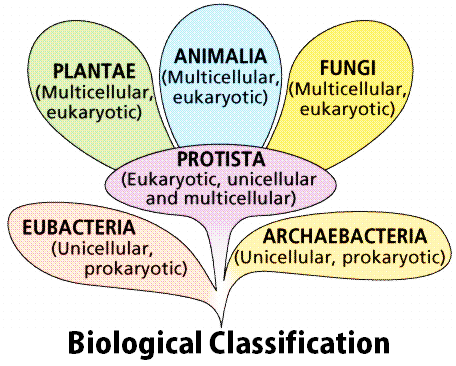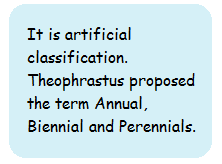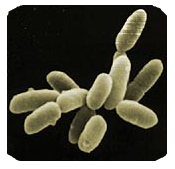Biological Classification
Table of Content |
|
|

 Biological Classification is the scientific study of arranging organisms into group and subgroup on the basis of their similarities and dissimilarities and placing the group in a hierarchy of categories.
Biological Classification is the scientific study of arranging organisms into group and subgroup on the basis of their similarities and dissimilarities and placing the group in a hierarchy of categories.
The purpose of biological classification is to organise the vast number of known plants into categories that could be named, remembered and studied.
Objectives of Classification
- To identity and describe all the possible types of species.
- To arrange the species in various categories on the basis of their similarities and dissimilarities.
- To evolve a truly natural or phylogenetic system which should indicate origin and evolution of the species.
- Helping in easy identification of organisms.
Topics Covered
Types of Biological Classification
There are three main types of classification-artifical, natural and phylogenetic:
Artificial System of Classification
It is a system of classification which uses one or two morphological character for grouping of organisms. Some artificial system have used habot and habitat for this purpose. Aristotle (c 350 BC) divided animals into two categories, enaima (with red blood) and anaima (without red blood). Aristotle also classified animals on the basis of their habitat- aquatic (e.g, fish, whale), terrestrial (e.g, reptiles, cattle) and aerial (e.g. birds, bat). Pliny the Elder (23-79 A.D.) used artificial system of classification for both plants and animals dividing them into land, air and water. Pliny distinguished animals into flight band nonflight ones. Flight animals included bats, birds and insects.
Natural System of Classification
It is a system ofclassification which takes into consideration comparable study of a number of characters so as to bring out nature similarities and dissimilarities and hence nature relationship among the organisms. The system employs those characters which are relatively constant. They include morphological characters, anatomical characters, cytological characters, physiology, ontogeny or development, reproduction, cytochemistry and biochemistry, experimental taxonomy, etc. the characteristics are helpful in bringing out maximum numberof similarities in a group and comparable differences with other group of organisms. For example, mammals are charactriesed by the presence of mammae, birds possess wings, feathers, pneumatic bones, ovipary, 4- chambered. They are coldblooded.
Phylogenetic System of Classification
Classification based on evolutionary relationship of organisms is called phylogenetic system of classification. It is based on the evolutionary concept from darwin’s book- on the origin of species by means of natural selection. The preservation of favoured races in the struggle for life (1859). It reflects the true relationships among the organisms. First phylogenetic system was proposed by Engler and Prantl (1887-99). Zoologists believe that since similarity in structure represents close evolutionary relationship, their natural classification represents evolutionary and phylogenetic classification.
History of Classification
1. Aristotle: Father of biology & father of zoology.
2. Theophrastus:
-
 He is known as father of ancient plant taxonomy and father of botany.
He is known as father of ancient plant taxonomy and father of botany. -
Theophrastus wrote many books on 'plants.
Few of them are as follows:
(a) Historia plantarum
(b) Causes of plants
(c) Enquiry into plants
-
Theophrastus gave names and descriptions of 480 plants in his book Historia plantarum.
-
Theophrastus proposes the first classification of plant kingdom. He classified plant kingdom in to four groups on the basis of growth habit. (a) Trees (b) Shrubs (c) Under shrubs (d) Herbs
3. Carolus Linnaeus: [1707 – 1778]
-
He is known as father of taxonomy, father of plant taxonomy and father of animal taxonomy.
-
Linnaeus gave the two kingdom system classification. He grouped plants and animals into kingdom plantae and kingdom Anirnalia respectively.
-
Linnaeus wrote many books. Some important books are:
(1) Hortus uplandicus - First book
(2) Flora lapponica
(3) Philosophia botanica
(4) Critica botanica
(5) Systema naturae (1737)
(6) Genera plantarum
(7) Species plantarum -last book (1753)
4. A.P. De Candolle:
-
He was the first to propose the significance of vascular tissue in taxonomy. On this basis of vascular tissue he classified plants into two groups
(a) Cellular plants (Non vascular plants) - This group includes Thallophyta and Bryophyta
(b) Vascular plants - This group includes Pteridophyta, Gymnosperm and Angiosperms.
5. George Bentham (1800 -1884) and Joseph Dalton Hooker (1817 -1911):
-
Both Bentham and Hooker were related to Royal botanical garden.
-
They wrote the book "Genera plantarum" (1862 - 1883).
-
In this book, Bentham and Hooker gave the biggest and natural classification of spermatophyta i.e. plants with seeds
-
In Genera plantarum, there is description of 202 families. In it, basically the description of plants with seeds is present.
6. A. W. Eichler:
-
Syllabus de vorlesungen uber phanerogamen kunde - Book written by Eichler.
-
In this book, Eichler gave the first phylogenetic classification of plant kingdom.
-
The classification of Eichler is very little phylogenetic.
-
In this way Eichler classified plant kingdom into five divisions and arranged them in the order of evolution (Phylogeny).

7. Engler (1844 - 1930) & Pranti (1849 - 1893):
-
Book - "Die Naturlichen Pflanzen Familien".
-
He gave the phylogenetic classification of plant kingdom. This classification was more phylogenetic as compared to Eichler's classification.
8. Oswald Tippo:
-
Proposed the biggest phylogenetic classification of plant kingdom.
-
This classification is the complete classification of plant kingdom.
-
This is the most acceptable classification for books and study.
(a) Cyanophyta:B.G. Alage
(b) Euglenophyta:Euglenoids
(c) Chlorophyta:Green algae
(d) Chrysophyta:Yellow-green algae
(e) Pyrrophyta:Dinoflagellates & Diatoms
(f) Phaeophyta:Brown algae'
(g) Rhodophyta:Red algae
(h) Schizomycophyta:Bacteria
(i) Myxomycophyta:Slime molds (False fungi)
(j) Eumycophyta:True fungi
9. Karl Menz:
-
He showed the importance of serology in taxonomy.
-
Similarities and dissimilarities in stru. of proteins help to know the phylogenetic relationship of living beings. Living organisms which are phylogenetically close relatives have more similarities in their proteins.
-
Organisms which are distantly related have different proteins.
|
(1) First tissue was originated in animal kingdom in → Coelentrata (2) First tissues was originated "in plant kingdom in → Bryophyta (3) Phylogenetic relationship of plants and animals can be established by animal serum. Serology indicates that chimpanzee is closest relative of man. |
-
Haeckel gave the three kingdom (Protista, Plantae, Animalia) system of classification.
-
Haeckel established the kingdom Protista.
-
Haeckel grouped those living organisms in Protista which did not have tissues.
-
Kingdom Protista: Prokaryotes, Protozoa, porifera, Algae & fungi
Five Kingdom Classification (from 1969 to 1990)
In order to develop phylogenetic classification, R.H. Whittaker (1969), an American taxonomist, divided all the organisms into five kingdoms. As the viruses are on the border line of living and nonliving, they have been left out. Whittaker has used five criteria for delimiting the different kingdoms.
1) Complexity of cell structure, prokaryotic and eukaryotic .
2) Complexity of body structure or structural organization, unicellular and multicellular.
3) Mode of nutrition which is divergent in multicellular kingdoms- photoautotrophy in plantae, absorptive heterotrophy in fungi and ingestive heterotropy in animalia. Photoautotrophy totrophic nutrition is also called holophytic nutrition while ingestive heterotrophy is known as holozoic nutrition. Absorptive heterotropy is saprobiotic (=saprophytic ) nutrition.
4) Ecological life style like producers (plantae), decomposers (fungi) and consumers (animalia).
5) Phylogenetic relationships.
Whittaker’s five kingdoms are monera, protista, plantae, fungi and animalia.
Table. Characteristics of five kingdom
S.No |
Characters |
Monera |
Protista |
Fungi |
Plantae |
Animalia |
|
1 |
Cell type |
prokaryotic |
Eukaryotic |
Eukaryotic |
Eukaryotic |
Eukaryotic |
|
2 |
Cell wall |
Non-cellulosic polysaccharide+ amino acid) |
Present in some (various types) |
Present (non cellulosic) |
Present (cellulose) |
absent |
|
3 |
Chloroplast |
Absent |
Present in some |
Absent |
Present |
Absent |
|
4 |
Mitochondria |
Absent |
Present in some |
Persent |
Present |
Present |
|
5 |
Nuclear membrane |
Absent |
Present |
Present |
Present |
Present |
|
6 |
Tissue or multicellularity |
Absent |
Absent |
Present but limited |
Present in all forms |
Present in all forms |
|
7 |
Motility |
Bacterial flagella, gliding or nonmotile |
Cilia,flagella amoeboid or contractile fibrils |
Cilia, flagella in some, none in most of the forms |
Cilia and flagella in lower forms, absent in most of the forms |
Cilia and flagella,contractile fibrils |
|
8 |
Mode of nutrition |
Autotrophic- chemosynthetic and photo- synthetic, heterotrophic (saprophytic and parasitic) |
Phosynthesis and heterotrophic |
Heteroprophic, saprophytic and parasitic absorptive |
Autotrophic by photosynthesis
|
Heterotrophic by ingestion |
|
9 |
Reproduction/- means of genetic recombination |
Conjugation transduction transformation or none |
Fertilization and meiosis, dikaryosis or none |
Fertilization and meiosis |
Fertilization and meiosis |
|
|
10 |
Nervous system |
Absent |
Primitive for conduction stimuli |
Absent |
Absent |
Present, often complex |
Three Domains of Life (Six Kingdom Classification) - 1990
-
The three- domain system is a biological classification which was introduced by Carl Woese, a professor in the department of microbiology, university of Illinois, Urbana- Champaign in 1990 that divides cellular life forms into archaea, bacteria and eukarya domains.
-
It emphasizes the separation of prokaryotes into two groups, originally called eubacteria (now bacteria) and archaebacteria (now archaea) because of their fundamental differences, Woese argued that each of the two arose separately from an ancestor with poorly developed genetic machinery, often called a progenote.
-
In fact the three-domain system is loosely based on the traditional five- kingdom system but divides the monera into two ‘’domains’’, leaving the remaining eukaryotic kingdoms in the third domain.
It is actually a six kingdom classification.
(1) Archaea domain:
The demain contains prokaryotic organisms which have a monolayer core of lipids in the cell memebrane and distinct nucleotides in their 16S RNA. It contains a single kingdom.
Kingdom archaebacteria
The kingdom contain early prokaryotes which live in extreme environments,
For Example:
(a) Methanogens - metabolize hydrogen and carbon dioxide into methane.
(b) Halophiles - live in salt.
(c) Thermoacidophiles – live in acid high temperatures (upto 110 degrees Celsius).
(2) Bacteria domain:
The domain contains prokaryotes which lack membrane covered cell organelles but do have a sort of micro chambers for separating various activities. There is a single kingdom.
The domain contains diverse type of bacteria having peptidoglycan cell wall, glycogen as food reserve,naked DNA coiled to form nucleoid, absence of sap vacuoles and presence of 70S ribosomes. Some common group are bacteria, my-coplasma, ctinomycetes, rickettsiae, spirochaetes, firmicutes, cyanobacteria.
(3) Eukarya domain. The domain contains eukaryotic organisms which originated by endosymbiotic association between some archaebacteria and eubacteria. It has four kingdoms- protista, fungi, plantae and animalia.
Viroids (L. Virus- Point, EIos – Diminutive)
-
They are the smakkest seif replicating particles which were discovered by Diener (1971).

-
They are obligate parasites.
-
The RNA is tightly folded to form circular or linear structure.
-
Viroids are known to cuse diseases (some 20) in plants only, e,g,. potato spindle tuber, chrysanthemum stunt. Animal or human infection is not known.
-
Viroud does not production is not very clear. Viroids particle can multiply by both RNA development and DNA dependent replication.
Prions (Prusiner,1983)
-
They are highly resistant glycoprotein particles which function as infectious agents.
-
They are formes due to mutation in gene PRNP.
-
They can also act as catalyst converting normal protein into prion state.
-
Prions are not affected by proteases, nucleases, temperature up to 800OC, UV radiations and formaldehyde.
-
Prions accumulate in nervous tissue and bring its degeneration. Common diseases caused by them are scrapie of sheep, mad cow disease, cruetzfeldt-jakob disease (CJD) and kuru.


Question1: Trinomial nomenclature of classification was proposed by-
(1) Linneaus
(2) Huxley and Stricklandt
(3) John-Ray
(4) Theophrastus
Question2: Most of the botanical names are drawn from the following language –
(1) German
(2) Greek
(3) Latin
(4) Spanish
Question3: Evolutionary classification is called –
(1) Artificial system
(2) Natural system
(3) Phylogenetic system
(4) None of the above
Question4: Which system classifies a plant in more than one groups?
(1) Practical classification
(2) Artificial classification
(3) Natural classification
(4) Phylegenetic classification
Question5: Author of book "Flora British Indica"
(1) Father Santapau
(2) J.D. Hooker
(3) William Rouxburgh
(4) G. Bentham


| Q.1 | Q.2 | Q.3 | Q.4 | Q.5 |
| 2 | 3 | 3 | 1 | 2 |
To read more, Buy study materials of Biological Classification comprising study notes, revision notes, video lectures, previous year solved questions etc. Also browse for more study materials on Biology here.
View courses by askIITians


Design classes One-on-One in your own way with Top IITians/Medical Professionals
Click Here Know More

Complete Self Study Package designed by Industry Leading Experts
Click Here Know More

Live 1-1 coding classes to unleash the Creator in your Child
Click Here Know More

a Complete All-in-One Study package Fully Loaded inside a Tablet!
Click Here Know MoreAsk a Doubt
Get your questions answered by the expert for free


